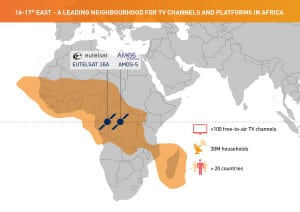Eutelsat and Spacecom Execs Explain Importance of Africa Partnership
[Via Satellite 11-21-2014] In a highly important strategic move, Eutelsat and Spacecom have joined forces to better serve the African broadcast market. The two companies have agreed to establish a framework for cross-commercialization of Ku-band capacity connected to the high-power African service areas of Eutelsat’s Eutelsat 16A satellite at 16 degrees east and Spacecom’s Amos-5 satellite at 17 degrees east.
“The question is not why we have done this but why we didn’t do it sooner,” admitted Rodney Benn, Eutelsat’s regional vice president for Africa, when the companies announced the partnership earlier this week. Benn also told Via Satellite that the deal was a “win-win” response to the African broadcasting market. “Our two satellites at 16 and 17 degrees east have identical Ku-band footprints and have naturally built an audience of millions of homes keen to pick up an existing offer of over 100 channels with a single dish,” he said. “It made good business sense to align our efforts and to collaborate on building a strong video neighborhood that serves the broadcasting community and taps into the total audience of 30 million homes in our combined coverage. Now, Amos 5 and Eutelsat’s viewers have the best of both satellites.”
The combined channel lineup of both satellites already comprises more than 100 FTA African and international channels that can be received by standard 80 cm dishes in a vast footprint covering more than 30 million TV homes located notably in Francophone Africa and extending to Ghana and Nigeria.
Amir Carmeli, Spacecom’s SVP of sales in West Africa and France told Via Satellite that there had been a steady growth in Africa for satellite operators and buoyant prospects for long-term growth. Carmeli says the move to digital broadcasting is redefining the television sector across the continent, while demand is high for quality Internet access across a profile of users that include enterprises, government agencies and consumers.
“If we look just at the broadcasting market and the 16/17 degrees east neighborhood, the last 12 months alone have seen the addition of four DTH/DTT platforms, with the energy coming both from African players and the international market,” he added. “Considering that the population in many African countries is expected to remain dispersed (80 percent rural) and frequently beyond range of terrestrial infrastructure, we are convinced that the long term perspectives for satellite are strong.”
Both operators believe they can generate stronger growth at the 16-17 degrees east position by leveraging their combined knowledge of Africa’s broadcast markets. For Spacecom, the region remains a critical strategic objective and this deal strengthens their position in the region. “From Spacecom’s perspective, Africa is the next market after Central and Eastern Europe, the Middle East and the East Coast of North America that are served by the Amos ‘hot-spot’ at 4 degrees west. In 2015, Amos 6 is scheduled to be launched and begin commercial operations from the same 4 degrees west ‘hot-spot’,” said Carmeli.
For Eutelsat, the deal is also a shot in the arm. “For Eutelsat, Africa is at the heart of its coverage with Ku- and C-band resources progressively built up over a period of 15 years. New capacity is scheduled to come online in 2015 on two new satellites: Eutelsat 8 West B that will deliver pan-African C-band coverage, and Eutelsat 36C that will bring new resources to the long established video neighborhood at 36 degrees east,” Benn added.
